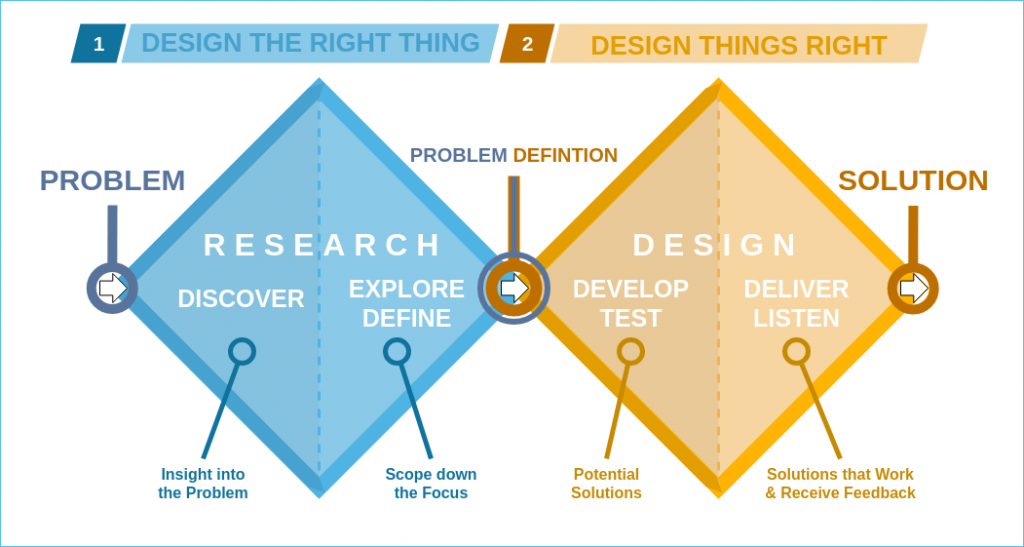
Design Thinking.
Esseen tyyppi: Yksilöessee / 2 esseepistettä.
KIRJALÄHTEET
| KIRJA | KIRJAILIJA |
|---|---|
|
Martyn Neumeier |
The Designful Company |
Design thinking is a non-linear, iterative process that teams use to understand users, challenge assumptions, define problems, and create innovative solutions to prototype and test. Involving five phases—Empathize, Define, Ideate, Prototype, and Test—is most beneficial to tackle ill-defined or unknown problems.
Design thinking is both an ideology and a process that seeks to solve complex problems user-centric. It focuses on achieving practical results and solutions that are:
- Technically feasible: They can be developed into functional products or processes;
- Economically viable: The business can afford to implement them;
- Desirable for the user: They meet a real human need.
The ideology behind design thinking states that, in order to come up with innovative solutions, one must adopt a designer’s mindset and approach the problem from the user’s perspective. At the same time, design thinking is all about getting hands-on; the aim is to turn your ideas into tangible, testable products or processes as quickly as possible.
With design thinking, teams have the freedom to generate ground-breaking solutions. Using it, your team can get behind hard-to-access insights and apply a collection of hands-on methods to help find innovative answers.
Design Council, a British organization, in 2005 created a process model called Double Diamond. Allows companies to apply design characteristics to find creative solutions and innovative ideas. It includes four steps: Discover, Define, Develop and Deliver.
Many companies adopted the Double Diamond design process, such as Apple, Microsoft, Starbucks, and others. An updated version of the Double Diamond was introduced in 2019, which is agile and visualizes how it can fit inside the organization.

The problem space is when designers explore the problem, including its complex nature, and end with a clear definition of the problem. It is where the majority of the unique design characteristics and values lay, including creativity and uncertainty. The second stage is the solution space, where ideas are generated, visualized, and tested prototypes. At the end of this stage, the final product is created and delivered to the end-user.
Step 1: Discover
The first stage is the exploration stage, as the team explores problems or the target project, such as exploring the root cause of the problem and applying field research to understand the target challenge. The target of this step is to examine and collect information about the design challenge.
Step 2: Define
The Define step is the convergent part of the problem space as it allows ideas to be narrowed into a clear definition of the problem. This definition is the one that will lead the team into the following prototyping and testing steps.
Step 3: Develop
Develop is the first step in the solution space. In this step, the team builds prototypes of the solution and tests it involving the end-user in the testing process through a divergent approach, which means that all types of solutions as prototypes. First, the team needs to clearly illustrate the target users by creating a persona for each target user. Persona is a virtual character representing the user and helps the design team consider the user’s characteristics during the prototype and development process.
Step 4: Deliver
The relation between the designer the product doesn’t end here. Once the product is delivered, the team starts to collect user feedback and expertise evaluation. These commons and feedback are used to improve the future versions of the product. The Deliver is a conversion step where ideas are narrowed to one final product.
The Five Stages of Design Thinking
Empathize
Here, it would help if you gained an empathetic understanding of the problem you’re trying to solve, typically through user research. Empathy is crucial to a human-centered design process such as design thinking because it allows you to set aside your own assumptions about the world and gain real insight into users and their needs.
In business, empathy can be used to understand the motivations of customers. Fellow employees, partners, and suppliers and create strong emotional bonds with people.
Define
You accumulate the information gathered during the Emphasize stage. You then analyze your observation and synthesize them to define the problems you and your team have identified. ( you can create personas to help you )
Ideate
now you are really to generate ideas, with the information from the last two phases you and your team can start thinking out the box, look for alternatives ways to view the problem and identify innovative solutions. (brainstorming is particularly useful here)
Prototype
Start to create the solution, this is the experimental phase, the aim is to identify the best possible solution for each problem found. Your team should produce some very simple and not expensive solution products.
Test
Evaluators rigorously test the prototypes. Although this is the final phase, design thinking is iterative: Teams often use the results to redefine one or more further problems. So, you can return to previous stages to make further iterations, alterations, and refinements – to find or rule out alternative solutions.
Overall, it would help if you understood that these stages are different modes that contribute to the entire design project rather than sequential steps. Your goal throughout is to gain the deepest understanding of the users and their ideal solution/product.
As an entrepreneur student at Tamk University, we need to understand Design Thinking, not just because we try to create some business, we need to understand and learn to work in a team, the Desing thinking helps leaders and team members to get involved more closely. No matter your background, if you are an IT expert or music engineer, design thinking will help you work together and bring the creative side from each member in the different stages of the process.
Martyn Neumeierin, in his book The design thinking company, he mentions and emphasizes design thinking as the cornerstone of companies, but unfortunately, many of the companies don’t use it. Instead, many of the companies only focus on earnings growth fast growth in a short time.
He recommends investing in vision, culture, innovation rather than in fast growth.
Can you apply Design thinking in many areas of your business?
Absolutely you can use it in the traditional areas of products and communications. You can use it in Marketing communications, online advertising, and brand identity, customer experience, customer service, online interaction, shopping environments, and many more.

https://www.interaction-design.org/literature/topics/design-thinking
https://uxdesign.cc/what-is-design-thinking-and-how-can-businesses-benefit-from-it-4543655c7be4
https://www.invisionapp.com/inside-design/what-is-design-thinking/
https://www.productplan.com/glossary/design-thinking/
The Double Diamond Design Thinking Process and How to Use it
https://www.martyneumeier.com/the-designful-company



